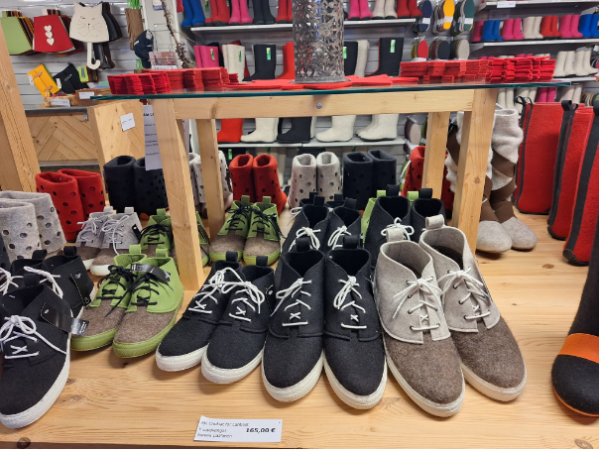
Bloggar
Travelling for wool in Estonia and Finland

Finnish Kainuu grey sheep at Ala-Kattelus farm in Jämsä. Photo: Ingvild Espelien
The journey to find ways to reduce the volume of wasted wool throughout the entire value chain continues in the Nordplus financed F.E.L.T Wool project. After the June project trip to Lithuania, a combined trip to Estonia and Finland was organized. In November a group of 13 people explored spinneries, felting studios, breeders of native sheep, and other wool related places.
The first place to be visited in Estonia was Villakamber spinnery. It is a family-owned company that cards sheep and alpaca wool, and spin yarn from sheep wool. They also conduct their own washing and do not accept pre-washed wools, to be able to control the whole process themselves. The current capacity is about 100 kg of wool per month. The spinnery was started with the use of EU rural development funds. Different rural financing instruments provided loans for the machinery, so the spinning mill was built piece by piece over 6-7 years. The spinning mill had also experimented with flax from the Finnish business Linen Stories, making yarn with 10 % linen and 90% wool. However, a larger share of flax could be used, according to the owners.
Additionally, Villakamber produces duvet blankets using lightly felted wool, a complimentary business to yarn spinning. The spinning mill owns machinery to produce quilted duvets that are made by order, but also other quilted products like blankets for kids, pillowcases and soon some clothing. This production helps increase profitability by manufacturing products from the same raw material that is used for yarn spinning.
Also, Estonia’s largest wool mill Aade Lõng was visited. In their products they use high quality wool, which mostly originates from Sweden, Australia and New-Zealand, but also from local Estonian sheep-farmers. Other places visited were related to arts and crafts and tradition, for example the FeltMill Felt Studio of Liina Veskimägi-Iliste. Liina is also a member of the Finnish Felt Association Filtti. The association’s chairperson Sirpa Mäntylä participated in the Estonian trip and helped to guide the group in the felting world of Finland.

Looking at wool products in Estonia. Photo: Liina Veskimägi-Iliste
After the versatile program in Estonia, the group took the ferry from Tallinn over to Helsinki in stormy winter weather and continued the trip towards the atmospheric Leineperi Ironworks in Ulvila, which is also the home for several shops with arts and crafts. Among them are the shop of Piritta Mäkinen with her Blacksheep Spinning Mill, selling carded wool from Finnish breeds in multiple colors, felted hats, bags, yarns and lots of other wool stuff.
As in Estonia, there is also one producer of blankets with wool filling in Finland, called Porin Villa ja Peite. The visit to this company had to be cancelled because of the challenging weather hindering the owner to arrive from Helsinki, though. The journey, however, continued to Jämsä, seeming to be the center of manufacturers of felt products. There have been up to seven factories making felted shoes in the village of Partala in Jämsä. Now there are two left: Lahtiset Felt Factory and J. Alho. Both factories make felt shoes for both indoor and outdoor use, but also other products, such as bags. Lahtinen is known for their long legged felt boots. J. Alho also makes sauna hats and coolers for drinks. Both have some experience from trying Finnish wool, but are currently manufacturing their products from imported wool, from e.g. England.

Felted shoes at the Lahtiset factory shop in Jämsä. Photo: Ulrika Dahlberg
Both in Estonia and Finland the participants got to see some native sheep breeds and to meet people working to preserve them. In the production chain, for smaller manufacturers and handcrafters, it is possible to use wool from native breeds, or native wool in general, from different breeds. For the slightly larger manufacturers, it seems the availability of native wool of the right quality in larger amounts is the problem, as usual. But, as the largest wool mill in Estonia is using native wool in addition to imported, it is not impossible if there is a will to make an effort.
To conclude, there are many possibilities to promote the use of Nordic and Baltic wool, through handcrafters, artists, teachers and local businesses with a will to focus on native wool. There is also potential to mix wool with other natural fibres, such as flax and nettle, to get different qualities of yarn for different purposes. What it takes is innovative people who want to learn about the traditional materials and have the possibility to experiment - and the right machinery. Also, consumers need to be informed about the properties, environmental and local economic effects of natural fibres, to start choosing for example mixes of natural fibres over mixes of natural and synthetic fibres or fully synthetic materials, when they are available.
F.E.L.T. WOOL - Future emergence of local textiles based on wool is financed by NordPlus Horizontal. The trip to Finland was organized in collaboration with the project NorNa - Nordic Natural Fibres in Circular Economy, which is funded by the The Swedish Cultural Foundation in Finland.
The blogpost has been reviewed by Novia's editorial board and accepted for publication on 16.12.2024. ![]()
Bioekonomi
Blogginlägg som är granskat av Novias redaktionsråd är utmärkta med nyckelordet "Granskat inlägg".
Vi följer CC-BY 4.0 om inget annat nämns.
Ansvarsfriskrivning: Författaren/författarna ansvarar för för fakta, möjlig utebliven information och innehållets korrekthet i bloggen. Texterna har genomgått en granskning, men de åsikter som uttrycks är författarens egna och återspeglar inte nödvändigtvis Yrkeshögskolan Novias ståndpunkter.
Disclaimer: The author(s) are responsible for the facts, any possible omissions, and the accuracy of the content in the blog.The texts have undergone a review, however, the opinions expressed are those of the author and do not necessarily reflect the views of Novia University of Applied Sciences.